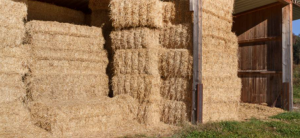 First-Cutting Hay for Horses: Buy or Bypass? Some horse owners snub first-cutting hay for horses, regardless of whether it is grass or legume. Why, you ask? Reasons abound.
First-Cutting Hay for Horses: Buy or Bypass? Some horse owners snub first-cutting hay for horses, regardless of whether it is grass or legume. Why, you ask? Reasons abound.Weeds:
Weeds can infiltrate any stand of hay if fields are not managed properly. A weedy, unkempt hayfield will be just as likely to produce weedy hay in the beginning of the season as in the end unless weed control is implemented between cuttings.
“While an occasional weed is not reason enough to discard an entire bale of hay, a proliferation of weeds offers nothing in the way of nutrition,” said Catherine Whitehouse, M.S., a nutrition advisor for Kentucky Equine Research (KER).
Waste is a consideration as well, as horses are more likely to sift through and refuse weed-ridden hay. Most importantly, not all weeds are harmless, so choosing weed-free hay is as much about safety as economics and nutrition.
Maturity:
Because of the unpredictable weather in spring, hay growers must sometimes postpone the harvest of first-cut hay. During this delay plants might become overly mature.
According to Whitehouse, mature hay is perfectly acceptable, even preferable, for some horses—easy keepers, certain metabolic horses, and the ilk—so keep this in mind when evaluating first-cutting hay.
Harvesting woes:
Weather can impact hay quality. Excess moisture in the hay at the time of baling might provide an environment ripe for mold growth. If moldy hay is fed to horses, it can cause gastrointestinal and respiratory problems severe enough to bring about grave illness.
Is it wise to summarily dismiss first-cutting hay?
“The answer to this question lies primarily in the horses that will eat the hay. If a thorough examination of multiple bales reveals good-quality hay with few weeds and no dust or mold, then there is likely a place for it in a feeding program,” said Whitehouse. First-cutting hays can be superior to later cuttings depending on the various factors involved in harvesting.
Nutritional value can be assessed through inexpensive chemical analysis, which will provide an equine nutritionist with the basic information necessary to create a nutritionally balanced diet for any horse.
Article Sources: Kentucky Equine Research
